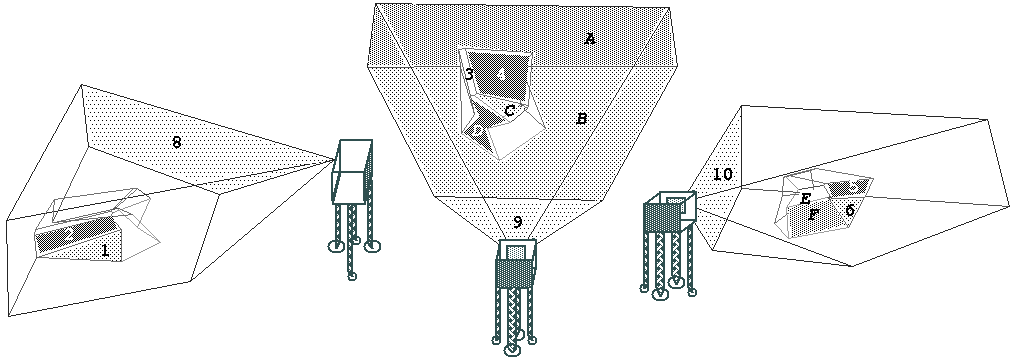Space Envelope Model Construction

A space envelope model is a CAD-type boundary description.
Instead of modeling a single object (or solid), a space envelope
encloses a bubble of empty space. The advantage is that in any given
view, there may be any number of objects, this number being difficult to
determine from pixel-data alone. However, there is always one and only
one visible volume of unoccupied space. Once a model has been constructed
defining the space envelope, higher-order operations may be applied to
reason about the scene's content. For instance, surface geometries and
topology could yield insight into the number of visible objects.
Similar to an
OPUS model , any data for visible portions of the scene are modeled
by real surfaces. Any portions of the scene not visible are
modeled by occlusion surfaces, representing the boundaries to
the as-yet-seen volume of empty space. In the above figure, the same
space envelope is shown from three different perspectives.
Real surfaces are labeled using letters, while occlusion surfaces are
labeled using numbers. Occlusion surfaces 8, 9 and 10 model three of
the four boundaries to the field-of-view of the sensor.
Motivation
In the coming virtual universe, where's all the 3D structural data going
to come from? The traditional method is to construct (program) objects
and worlds by hand. This work strives towards methods to automatically
construct models from image data. For instance, you could walk through
your home with a camera, snapping images, feed the images into the
model builder, and presto! Virtual reality representation of your home.
Related publications
- The Space Envelope Representation for 3D Scenes,
Ph.D. dissertation, compressed, tarred postscript
(400 DPI; 3,830 Kbytes)
- The Space Envelope Representation for 3D Scenes,
in CVIU, vol. 69 no. 3, pp.310-329, March 1998 , compressed postscript (400 DPI; 423 Kbytes)
- Dynamic-Scale Model Construction from Range Imagery,
to appear in IEEE-TPAMI, compressed postscript (400 DPI; 174 Kbytes)
C code
A
tar file containing C code which constructs space envelope models from
range images, as reported in the publications above, and as demonstrated
below.
Examples
Click on any image icon to download the space envelope model in
VRML v1.0 format .
Occlusion surfaces are shaded in bright greens. Glue surfaces (an
artifact of model construction process, usually extremely small) are
shaded in bright reds. The boundaries to the field-of-view of the space
envelope model are shaded bright blues.
Real surfaces use all other colors. Please note that
VRML is a
developing language, not intended for solid modeling. Webspace will
view these models correctly, but you must get inside the model
to see it; otherwise, try wireframe viewing.
 back to the
Island Vision Group at USF home page
back to the
Island Vision Group at USF home page
The space envelope model / USF / hoover@bigpine.csee.usf.edu

